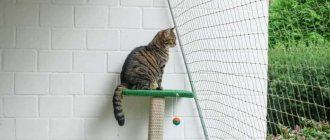It is difficult to find a person who has never encountered a cat. These pets live in almost every family. They are affectionate and calm, not demanding of attention and do not require complex care. But cats are also famous for their wayward behavior. Sometimes their disobedience can become a serious problem for their owners. Often, it is people who are to blame for the fact that their pet becomes nervous and aggressive. Below we will tell you about 10 common mistakes made by cat lovers and how they can be corrected.
If your cat scratches and damages furniture, you can stop her from this habit
All cats need to sharpen their claws from time to time. And they do this on furniture, wall corners, door frames and thresholds. Of course, things are greatly damaged by their claws. Therefore, owners often buy special scratching posts and entire playhouses for their cats. But pets often ignore them and continue to damage the furniture.
Typically, people blame this on the cat's willful nature, which is difficult to train. But as practice shows, this may be the owner’s mistake. If the scratching post is poorly secured and wobbly, cats will simply ignore it. They don't like it when the surface starts to move. That's why they choose furniture that is almost impossible to move.
We’re making a cute curtain for a child’s room with eyelets: pieces of different fabric will come in handy
Sasha plus Sasha: why Ursulyak and Golubev could not save their student marriage
Cutlets are many times tastier, although the ingredients are the same: we make a luxurious roll
Veterinarians advise choosing stable nail sharpening posts made of heavy materials. Before purchasing, check to see if the scratching post is wobbly. You can also choose a horizontal post that is simply placed on the floor. Pay attention to accessories with pheromones - they will attract the cat.
It is also worth thinking about retraining your pet. Scold him when he sharpens furniture and praise him when the cat uses a scratching post.
Radical weaning methods
This was a list of the most effective and proven devices and methods, but if even after using them the problem remains, you should use more radical ones:
How to train a kitten to use a litter box - correctly, quickly and easily train a cat to use a litter box (125 photos)- How to raise a kitten - tips and recommendations on how to properly raise an affectionate and tame kitten (135 photos)
How to get rid of the smell of cat urine - 125 photos of ways to remove the unpleasant smell of a cat
- Silicone claw pads. They are attached with special glue and do not create discomfort for the animal, but will last no more than 2 months, then they need to be replaced;
- Thick furniture covers;
- Special materials and coating can stop a cat from scratching doors, wallpaper and furniture. To do this, you can completely or partially cover the area accessible to the furry one with tiles, plastic panels, paint, plaster, fiberglass wallpaper;
- Close the door to the room with your “favorite” place.
If it so happens that you are a resident of an apartment, and not a private house, in which your tailed companion has the opportunity to walk around the yard and perform manicure procedures on trees and other surfaces, without damaging the interior, then learn to understand the mood, feelings and needs of the pet, without use of physical force and punishment.
A cat is a domestic animal with a fairly high level of intelligence, and perhaps it simply lacks the attention and care of its owner.
Brush your cat more often if she frequently vomits hair.
Cats constantly lick themselves, and, as a rule, they do not spit out the fur, but swallow it. Their stomach cannot digest it, so it accumulates in clumps. In turn, they come out along with vomiting. Sometimes a cat vomits almost every day, which, of course, cannot but worry the owner. The situation gets worse during molting.
How to prevent hair vomiting in cats? It's simple: try to comb it more often. Daily brushing is recommended for furry pets. Use special slicker brushes during shedding to remove the bottom layer of fur.
If brushing doesn't help, you can have your cat trimmed by a veterinarian. But remember that frequent vomiting can also be a sign of health problems.
Features of the manifestation of cat aggression
Knowledge of cat psychology will help you understand the reasons for bad behavior. Most cats are not prone to unmotivated aggression.
A mentally healthy animal never attacks, scratches or bites for no reason. As a rule, such behavior is a reaction to some external stimulus.
The most common causes of aggression in cats are:
- desire to protect oneself and one’s territory;
- sexual arousal;
- painful sensations.
Aggressive behavior is also sometimes observed in kittens that have suffered abuse.
The owner should understand the reasons for the animal’s anger. If a cat is constantly stressed, over time its psyche will become unstable, and it will truly become inadequate.
If your cat wakes you up at night, you can adjust its daily routine
Cats are natural hunters who catch their prey at dawn. Therefore, even pets often wake up at night and wake up their owners. You can try to correct your cat's behavior by monitoring his activity. For example, before going to bed, you can tire him out with games so that he sleeps more soundly until the morning. Cats may also scream at night due to hunger. Make sure your pet's bowl is not left empty in the evenings.
Lent and children: what children can and what they should avoid
Pushkin once admitted that he had a good attitude towards envy: how he explained it
Slimness, mood and attraction: why women need chocolate
Sometimes nighttime activity can also be caused by health problems. Cats sleep poorly due to arthritis and thyroid disease. Contact your veterinarian to rule out these pathologies if your cat is overly active.
Nail trimming
Scratching posts only partially solve the problem. Many owners also prefer to trim their pet's claws. Doing this on your own is not always easy: cats are very smart animals, so having tried this procedure once, they will try to avoid repeating it. Even if your pet is calm about trimming its nails, you need to do it very carefully, and preferably together.
To trim the claws, special pliers are used, similar to branch pruners.
Please note that there are capillaries running inside the claw; you only need to cut off the outermost part of the claw, where there are no capillaries. Otherwise, the procedure will be painful for the animal, and the damaged claw will take a long time to heal. And certainly after such a tragic operation the cat will not let you near you next time.
To ensure that neither the cat nor its owners suffer from nail trimming at home, take your animal to the veterinarian: all clinics offer nail trimming services. The procedure takes less than five minutes, and when performed by a qualified professional, it will ensure that your pet's claws remain healthy.
If the cat refuses to go to the litter box, it needs to be replaced.
Keeping a cat in an apartment requires installing a litter tray. But sometimes the animal refuses to go into it, shitting on the floor or even on the furniture. Again, owners blame the wayward nature of their pets. But veterinarians do not advise drawing hasty conclusions. Perhaps you just picked the wrong tray.
Cats do not like to use small litter boxes with low sides. They feel vulnerable in them. Try purchasing an accessory with high walls, behind which the cat can retire. Do not place the litter box in a crowded place, as this may scare your pet away. A cat will ignore a litter box if it is located close to noisy things, such as a washing machine, oven or microwave.
Also remember that each cat needs a separate container. Dominant animals can frighten weaker ones with their smell, so they will go to the toilet in the wrong place.
What does the third wife of the star of the series “Ivanov-Ivanov” look like: new photos of Louise
Deceivers themselves most often fall for misinformation.
Good luck in love for those born in the year of the Tiger: feng shui forecast for March 2021
If a cat goes to the toilet past the litter box, this may also indicate a disease of the genitourinary system. As a rule, in such cases, urination becomes frequent and painful for the animal.
Using a scratching post
The most popular way to eliminate the problem is a scratching post - a device for grinding down claws. You can buy it at the store, or make it yourself. Often, felt, rope, or carpet are used for this.
Scratching posts can come in different models, shapes, and sizes. They are equipped with cat houses, presented in the form of individual poles, planks, or entire complexes for games. They are also made from different materials - wood, jute, cardboard. It’s better to take a scratching post that is similar to the material your pet loves.
But it’s not enough to just install an object for grinding claws in the house; you also need to get the animal interested in it. Anyone who has experience with cats knows how capricious they are. It is also known about the curiosity of cats, which is important to emphasize when teaching not to peel off the wallpaper and the sofa.
- The scratching post is placed in the places where the cat likes to be most. If you have several favorite areas, you can buy a couple of models and install them around the house. The structure must be well secured so that the cat can lean on it while grinding its claws.
- It is important to regularly attract the kitten’s attention to a new toy by running its paws along the rough surface.
- If the animal does not understand that a new object in the house is intended for grinding off its claws, do not scream or hit the pet. You need to train him, because cats are smart animals. When the cat starts to scratch the wallpaper, you can use a spray bottle of water to repel it, and then take it to the scratching post. Showed interest in a new accessory can be encouraged with a treat.
Many cats, when meeting their owner, stretch and extend their claws. If you place a scratching post near the front door, this will keep the wallpaper intact and encourage the animal.
If your cat hunts wild animals, do not let her stay outside for long periods of time.
Hunting rodents and birds is normal behavior for a cat. Their instinct cannot be suppressed, so pets often bring dead animals to their owners. This is how they try to express their love to you. Of course, people are unlikely to appreciate such a gift. But is it possible to stop a cat from hunting?
Unfortunately no. Veterinarians have not yet found a way to help with this. The only way out is to prohibit the cat from walking outside. Then she simply will have nowhere to catch mice and birds.
Why is it important for a cat to have claws and scratch with them?
Claws are of vital importance to a cat physically, socially and emotionally. Scratching is not only a natural part of cat behavior, but also a necessary act:
- In this way, cats get rid of the dead shell of their claws, maintaining their sharpness and combat readiness.
- The scratching process is a kind of exercise that serves to stretch and strengthen the animal's upper body;
- By scratching objects, cats visually mark their territory and indicate their position in society (this happens especially often in houses where several individuals live);
- With the help of scent glands located on the paws between the toes, the pet leaves its scent in places where it scratches.
If your cat scratches and bites, you should consider retraining her.
Some cats get too carried away while playing, starting to scratch and bite their owners' hands. People themselves are largely to blame for this, because they unknowingly encourage such behavior. Veterinarians advise changing your play style to stop your cat from scratching and biting.
Seychelles opened borders: entry rules for Russians
Looks like a child: how monkeys eat candy (video)
Forgiving your ill-wishers is an indicator of strength: a parable that teaches this
Do not use your fingers, hands or feet to play with them. Scream loudly if the cat grabs your skin. This will scare the pet and it will retreat.
What to do if your cat scratches
To stop a cat from scratching, you can use the tips we gave above or try these:
- To stop the kitten from rushing and scratching, you can use its natural fear - throw a towel or light pillow over it. The sudden onset of darkness will sober up the child who is playing up, and an association will form in his head: if I scratch, it’s dark. Be patient, raising a kitten is a long process.
- If a kitten or adult animal scratches while playing, distract its attention. Take your hands off. Invite him to play with a toy or teaser. Be adamant and stop all attempts by children and guests to play with the animal with their hands.
- Try to stop your kitten from scratching using noise. Every time the animal releases its claws, stop the raging “aggressor” with a loud sound. You can clap your hands sharply, hit the pan with a spoon, or drop something on the floor. The cat is sobered by sharp loud sounds. If you repeat “sound punishment” constantly, the cat will learn a lesson, and it will be possible to prevent an attack on a person with this sound.
- If you use the words “no” or “teeth” to discourage biting, do not use them when your cat scratches you. Choose another conditional punishment word. For example, “claws” or “paws”. You need to say the punishment word in a loud, calm voice every time the animal tries to use its claws on you, your household or guests.
If none of the above helped you, remember how a mother cat teaches kittens. Gently grab the “furry aggressor” by the scruff of the neck – in this position he will immediately calm down and become quiet!
Don't give your cat food from the table unless you want her to constantly beg.
It’s unlikely that anyone would like to dine next to a annoying pet who is constantly begging. This is usually encouraged by the owners themselves. They treat cats with their food from time to time, and then are surprised when they begin to demand it.
Veterinarians do not recommend feeding cats from the table. Human food will not benefit your pet, especially if he eats quality food. Fill the bowl before you eat. Then the cat will be busy with his food and will not bother you. If your pet is too stubborn, you can lock him in a separate room during lunch.
Anti-scratch: claw covers
Why do you need anti-scratch pads for cats? How to put them on correctly?
In what cases can anti-scratch for cats come in handy?
If you have small children in the house, it is better to choose a more drastic way to deal with unwanted scratches, because as a result of playing with a frisky cat, not only your baby’s hands can suffer. To prevent the animal from causing injury with its nimble claws, hide them in special caps made of silicone. Soft claws or anti-scratch for cats are made in the shape of a claw, do not affect the movement of the animal, allow the cat to retract its claws, and do not put pressure on the nail bed.
How to wear anti-scratch boots?
The caps are attached to the claw using a special glue that does not cause irritation to the animal. Since the claw is constantly growing, the time of contact of the glue with the nail bed is very short; as the claw grows, the cap moves away from the nail bed, without causing discomfort to the animal. Typically, anti-scratch products for cats are applied only to the apron of the paws, but if your pet often uses the claws on its hind paws, then “shoe” them too.
Wearing anti-scratch pads also has a certain therapeutic effect. Some cats love to chew their claws, so much so that the claw begins to peel off. A cap that is put on prevents the claw from delaminating, and a healthy claw that grows under the cap sheds the old shell along with the cap. It takes an average of 4-6 weeks for the outer shell of the claw to grow back, so by putting anti-scratch guards on your cat, you will forget about painful, unsightly scars and scratches for at least a month.
Video: how to put on anti-scratch guards for a cat?
It should be noted that not all cats will be comfortable with wearing these “shoes” for claws. The natural desire of an animal is to get rid of a foreign object on its paws. There were cases when the effect of the caps lasted exactly as long as it took the cat to chew on the caps it didn’t like, i.e. for three or four hours, after which the animal began to scratch with renewed vigor. Fortunately, not all cats are so picky; most quickly get used to the anti-scratch guards: for some it will take several hours, for others several days, after which the animal will live its usual life, not paying attention to the caps placed on the claws.
If your cat is acting aggressively, you should seek help from a veterinarian.
Sometimes cats can be aggressive towards people and other pets. Their bad upbringing is not always to blame. Aggression can be caused by health problems. Thus, cats often attack people when they suffer from anxiety and severe pain. Therefore, you should definitely go for an examination to a veterinarian to find out the cause of the aggression.
The main reasons for this behavior
In order to overcome the problem, you first need to know why cats scratch furniture, whether this can be considered normal pet behavior, and what contributes to this.
Here are a few main points that will answer these questions:
Physiological need - for the natural replacement of old claws with a keratinized layer with young ones. The process speeds up and becomes less uncomfortable for the animal if it grinds them down.
Warming up and warming up the muscles. An apartment cat needs to keep himself in shape, because nature has a hunter instinct in him, which is limited in a small area. Scratching in this case is the way out.
Territory marker. The paw pads, in contact with the surface of the furniture, leave a characteristic odor that is secreted by the sweat glands. This is how the cat marks its territory in the house.
Relieving tension and stress. Cats are very susceptible and prone to stress, so the cat scratches the furniture, thereby relieving tension.
Instinct. Releasing claws is a skill inherent in genes.
Constant itching is a sign of an allergy
All cats love to wash themselves. But they don't do this all the time. If a cat nervously licks itself for 1-2 hours, it may suffer from itching. This is also indicated by the habit of scratching the skin to the point of wounds.
Severe itching is often caused by parasites: fleas or ticks. You can find them by running a comb through the fur. Black dirt in the ears is a sure sign of mites.
Often itching is caused by allergies. It can appear due to poor nutrition, the use of aggressive shampoo, or serious illnesses.
Photo tips on how to stop a cat from scratching furniture
Read here Taurine for cats - benefits, harm, dosage and features of use in the diet of cats (90 photos)
Help the site, share with friends 
Cat instincts, character and habits
Cats, like people, have been endowed by nature with a wide range of emotions and feelings, which they readily demonstrate to people.
If you pay close attention to your pet, it is not at all difficult for the owner to understand whether the cat is angry or happy, trusts or is wary, loves or hates. The animal conveys its feelings through facial expressions, voice (purrs, meows quietly or loudly, growls, hisses) or actions. However, there are often incomprehensible moments in the behavior of furry friends that cause bewilderment. For example, why does a cat bite and scratch when you pet him? After all, he purrs and rubs against his hands, and, therefore, it is pleasant for him, but the claws and teeth that painfully dig into the skin indicate the opposite. Some owners even move around their apartment with caution, expecting every moment an insidious attack from their domestic “tyrant.” Again the question: why does the cat rush to his feet and bite? Is this his game or is he realizing his hunting instincts? In fact, there are many situations where cat “domestic violence” occurs, and in each case such behavior has its own reasons and explanations.
Selecting anti-scratch products
To choose the correct size of caps, you need to know the weight of your pet, then use the size chart to select the anti-scratch caps that are suitable for your animal. The color scheme - from transparent to glamorous - is a matter of your taste. Some people buy soft claws to match the color of their pet’s fur coat, while others, on the contrary, buy them in a contrasting shade. Formal “shoes” are more suitable for cats, and brighter colors for cats. Regardless of the color, a set of anti-scratch pads - 20 pieces - will cost the owners about 300 rubles.
Our life is a game
And yet, no matter how much we try to pacify the nature of our pets, no anti-scratch for a cat will help if the animal does not receive enough love and affection from us. Often the problem arises only because we spend little time with the cat, she gets bored in our absence, and when we finally arrive, tired, from work, she splashes out all her unspent energy on us, running, jumping, scratching. There is only one way out: play with the cat, let her play around a little. Make sure that the cat has enough toys, and these can be toys sold in pet stores - mice, birds or balls, or completely ordinary household items. There are cats that adore small objects, for example, cosmetic sticks or dry beans: you can watch for hours how the cat squeezes the bean between the pads of its paws, then releases it and chases it throughout the apartment. If neither scratching posts, anti-scratchers, nor playing with your cat helps, and she continues to scratch and behave aggressively, contact a pet behavior specialist. And always remember – there are no hopeless situations! Love your cat, and in return she will give you her warmth, affection and good mood.











